Propagating plumerias is a great way to expand your collection, or share your favorites with friends.
In this post, I’ll talk about the different methods, tell you when and how to take cuttings, and then show you how to root them, step-by-step.
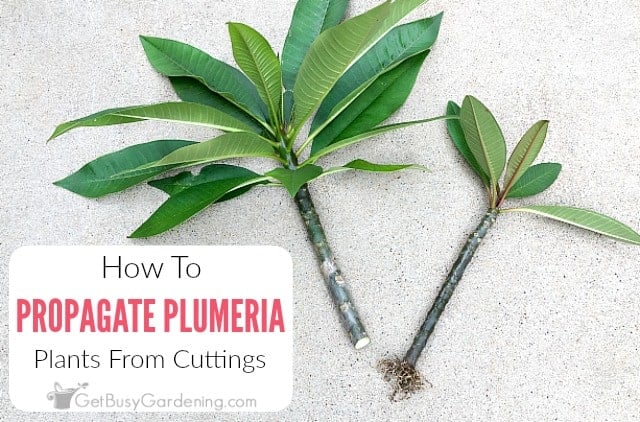
Though it sounds like it would be difficult, plumerias (aka: frangipanim, kalachuchi, or Hawaiian lei tree) are surprisingly quick and easy to propagate.
Below I’ll talk about the different methods you can try, and then dive into all of the information you need to know, including my best tips for success.
It’s fun and addicting once you learn how, and I’ll walk you through the exact steps in this detailed guide for propagating plumerias.
Can You Propagate Plumeria?
Over the years a lot of people have asked me “can I grow plumeria from a cutting?“. Well, I’m sure you know by now that the answer to that question is YES!
Since I’ve been asked that so many times, and I have several years of experience doing it myself, I finally decided to write a step by step tutorial on how you can do it too.
Plumeria Propagation Methods
There are two main ways to propagate plumerias: from seed or by rooting the cuttings.
In this article, I will show you how to grow plumeria from cuttings. I’ll save the seed starting for a future post.
I know it sounds scary, but it is actually pretty easy. First, let’s talk about when is the best time to try it.
When To Take Plumeria Cuttings To Propagate
The best time of the year to take plumeria cuttings for propagation is in the warm spring and summer months, especially when it’s humid outside.
If you take them too late in the summer, or in the fall as the mother plant is starting to go dormant for the winter, then they probably won’t root, or it will be much slower.
Rooting Plumeria Cuttings In Winter
Plumerias go dormant during the winter, so if you take the cuttings too late, they will likely won’t root. However, if you store them correctly, you can overwinter them until spring.
Just wrap the cutting with paper, or leave it in the pot and keep the soil completely dry. You can mist it every once in a while if you want, but don’t overdo it or it could end up rotting.
Then in early spring, give it a good, deep drink, and follow the step by step instructions below for rooting it.
How To Cut Plumeria For Rooting
There are a few things you’ll want to keep in mind when cutting plumeria stems and branches for rooting.
It doesn’t make a difference where you cut it, so it’s just a matter of how big or small you want it to be. You can root any size cutting, but you’ll have the best chance if it’s at least 3-4″ long.
But you do want to be sure to use a sharp pair of pruners, and always sterilize them so you get a nice clean cut.
Also, plumerias are very prone to tip rot, so it’s extremely important to always make your cuts at a downward angle so that water can’t settle into the wound.
How To Grow Plumeria From Cuttings
Before you get too excited and stick your plumeria cutting directly into the dirt, there are a few steps you’ll need to take to prepare it for the best chance of success.
First, remove the leaves from the cutting. This will allow it to put all of its energy into producing new roots, rather than maintaining the foliage.
Second, be sure to allow the wound to cure (dry out) before you attempt to root it. This step is super important, so don’t skip it, otherwise your plumeria cutting will likely rot instead of forming roots.
To do that, simply let it sit in a dry place until the wound is completely callused over. This can take several days to over a week, so be patient, and don’t rush it.
Related Post: How To Grow Plumeria In A Pot
Rooting Plumeria Cuttings In Water
Another common question I get asked is “can I root my plumeria in water?“. The short answer is yes, technically it is possible.
However, rooting frangipani cuttings in water isn’t always a huge success. Many times, the stems will only rot.
If you have plenty of extras to work with, then by all means experiment with this method. It’s always fun to try something new.
My preferred plumeria propagation method however is rooting them in soil. So, I’ll stick to that for now.
Planting Plumeria Cuttings In Soil
The best soil for rooting plumeria cuttings (also called “medium”) is one that is very quick-draining and doesn’t hold much moisture.
I make my own by combining equal parts of perlite, potting soil, and coarse sand, but you can use a commercial mix instead.
When planting a plumeria cutting in soil, it’s very important that you always use a clean pot to avoid any type of contamination.
Also, make sure you don’t use a huge container for rooting each cutting, otherwise you risk overwatering, which will only cause it to rot.
I use 4″ pots for rooting most of mine, and once in a while I might go up to a 6″ one for larger stems or branches.
Related Post: How To Choose The Best Plumeria Soil
Plumeria Cutting Care While Propagating
For the best chance of rooting, keep the air around your plumeria cutting humid, but the soil on the dry side.
If you live in a humid climate like I do, you don’t need to do anything special. Simply leave it outside, and soon it will root. Just be sure to keep it out of the full sun until then.
But, if you live somewhere dry, or you’re trying to root one indoors, then it’s a good idea to mist it every couple of days with a plant sprayer.
Just don’t water the soil, you want that to stay on the dry side. If it’s too damp, it will only cause your plumeria cutting to rot, and you don’t want that.
You’ll know your cutting has successfully rooted once you see new leaves forming the top.
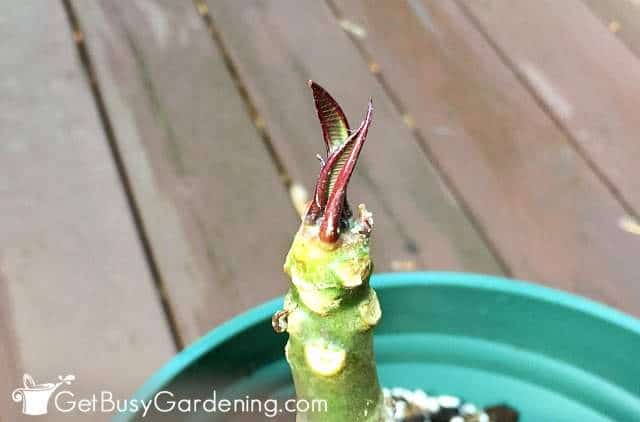
How Long Does It Take Plumeria Cuttings To Root?
How long it takes for plumeria cuttings to root depends on the environment. But in the right conditions, the roots will start forming in as little as 2-3 weeks.
However, if it’s really dry, wet, or too cold, then it will take much longer. For the fastest results, keep them in a bright, warm, and humid location out of the direct sun.
Why Is My Plumeria Not Rooting?
Your plumeria may not be rooting due to over or under watering, lack of light, or the temperature is too cool.
The soil needs to be kept on the dry side at all times, and it should never be wet. A moisture meter can help you maintain the perfect balance
Also, the roots will form best when it’s between 75-85°F. You can use a heat mat placed under the pots to speed things up.

Transplanting Plumeria Cuttings After Propagation
Once your plumeria cutting has several mature leaves, then you know it’s propagated and ready to move into a new pot or the ground.
You certainly don’t need to worry about transplanting your kalachuchi cutting right away, you can leave it in the small container until it becomes pot-bound if you’d rather.
The best potting soil to use is a porous fast-draining mix, and you should always plant them a container that has drainage holes.
Or you can try to make your own by mixing coarse sand and perlite or pumice with general potting soil.
Once your new baby has become established, you can start fertilizing it to encourage flowers, the cuttings can bloom their first year.
Related Post: How To Care For Plumeria Plants (Hawaiian Frangipani)
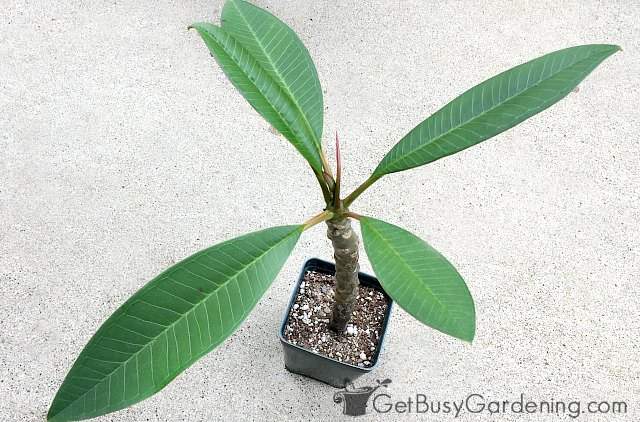
Plumeria Propagation FAQs
Below I’ll give you answers to the most frequently asked questions about rooting plumerias. If you can’t find what you’re looking for here, add a comment below.
Can You Replant A Broken Plumeria Branch?
Yes, with some care, you can replant a broken plumeria branch. Make sure the branch is dry and not rotten. If the broken end is mangled or crushed, then cut off the damaged parts so you have a clean edge. Clip off the leaves, and leave it to dry in a shady place for a few days. Then follow the steps below to root it.
How fast do plumeria cuttings grow?
Plumeria cuttings can grow very fast in the right conditions. It can take as little as 2-3 weeks for the roots to start forming.
How long do plumeria cuttings last?
Plumeria cuttings can last several months without being planting. However, they will slowly start to shrivel over time, so the sooner you root them after they’re properly callused, the better your success rate will be.
Can frangipani be propagated in water?
Yes, frangipani can be propagated in water. However, it’s not the best method to use, as the cuttings can easily rot. It’s a fun experiment to try if you have extras, but for the greatest chance of success, I recommend rooting them in soil.
Can you plant a fresh plumeria cutting?
While you can plant a fresh plumeria cutting, I highly recommend you let dry and fully callus over first. If you try planting it with a fresh cut, it has a much higher chance of rotting rather than rooting.
Plumeria propagation by cuttings sounds like it would be really hard, but it’s actually pretty easy when you follow these steps. It’s really fast too, so once you get the hang of it, you’ll have plenty of new starts to share with friends!
If you want to learn how to multiply any type of plant you can get your hands on, then my Propagation Made Easy eBook is for you! It has everything you need to know in order to start propagating your favorites right away. Download your copy today!
More Plant Propagation Posts
- The Best Plant Propagation Tools, Equipment & Supplies
- Plant Propagation: A Detailed Guide For Beginners
- How To Propagate Aloe Vera By Division
- Propagating Christmas Cactus From Cuttings Or By Division
- How To Propagate Banana Plants
- How To Propagate Snake Plant (Sansevieria) In Water Or Soil
Share your plumeria propagation tips in the comments section below.
Step By Step Instructions
How To Propagate Plumeria Cuttings

Rooting plumeria cuttings is easy once you know the right way to do it. Follow these detailed step by step instructions for the best results.
Instructions
- Take and cure the cutting - Use a clean pair of sharp pruners to take 3" or longer plumeria stem or branch cuttings. Then place them in a dry location out of direct sunlight for at least a week, or until the wound has callused over.
- Prepare the rooting medium - Use a commercial fast-draining medium, or try mixing equal parts of regular potting soil with perlite and coarse sand. If it's bone dry, dampen it slightly. Then use your trowel to fill the pot.
- Apply rooting hormone - Dust the callused end of your plumeria cutting with rooting hormone. This will help it produce strong, healthy roots, and also make the process faster.

- Plant the cutting - Make a hole in the medium that’s deep enough so the cutting will stand up on its own. Put the cut end into the hole, and gently pack the soil down around the base. The roots will sprout out of the bottom of the stem, so you don't have to plant it very deep.

- Place somewhere warm and bright - Put your cutting in a humid location with bright light. Placing it on top of a heat mat can speed things up, but it’s optional. Once you see new leaves on top, that means your frangipani cutting has rooted. You can pot it up into fresh soil if you want, but only go one size larger than the current container.
Notes
- The larger your cutting is, the longer it should cure. You'll know it's ready when the cut feels dry and hard. Do not skip this step or it may end up rotting.
- While your plumeria cutting is rooting, keep the medium on the dry side. If it’s too wet, the cutting will likely rot. You can use a moisture gauge to monitor it.
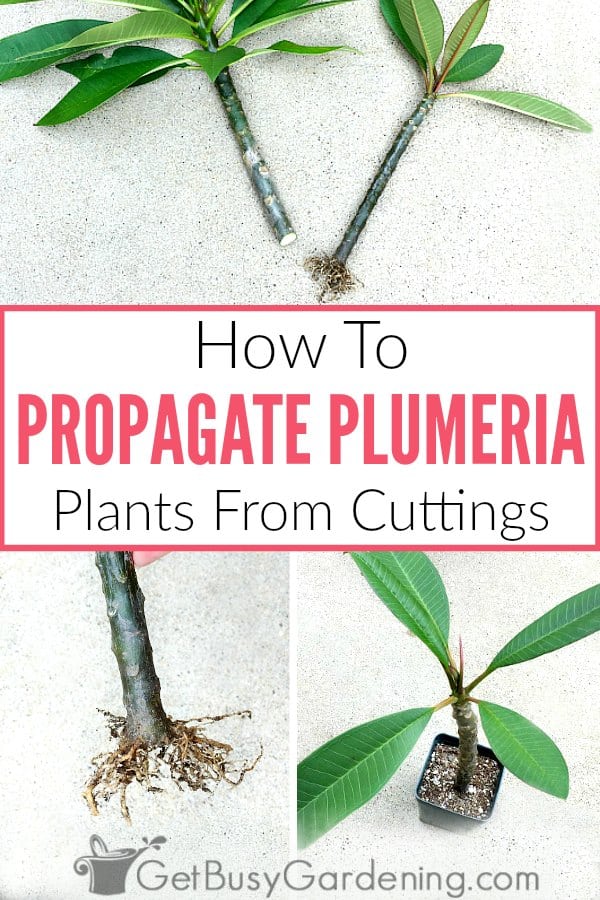
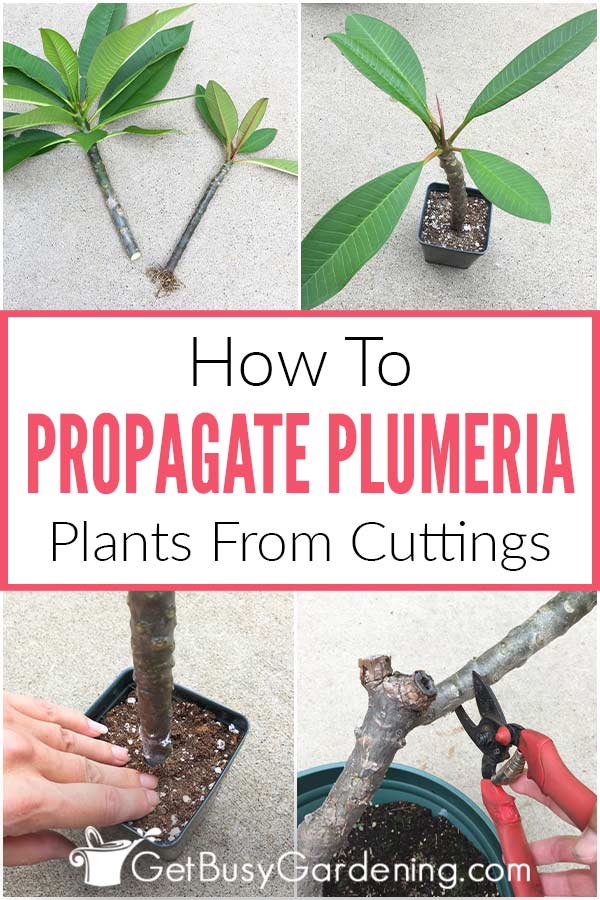
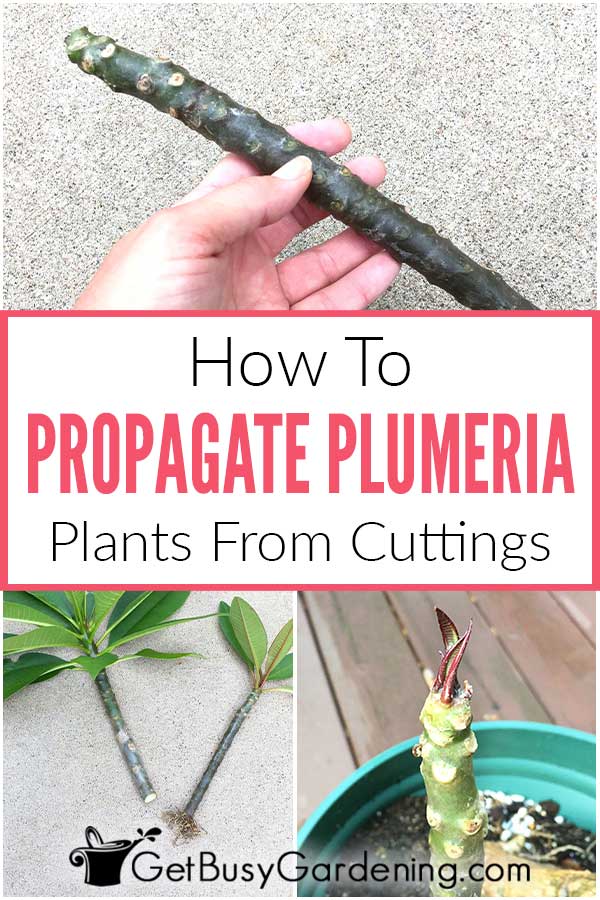

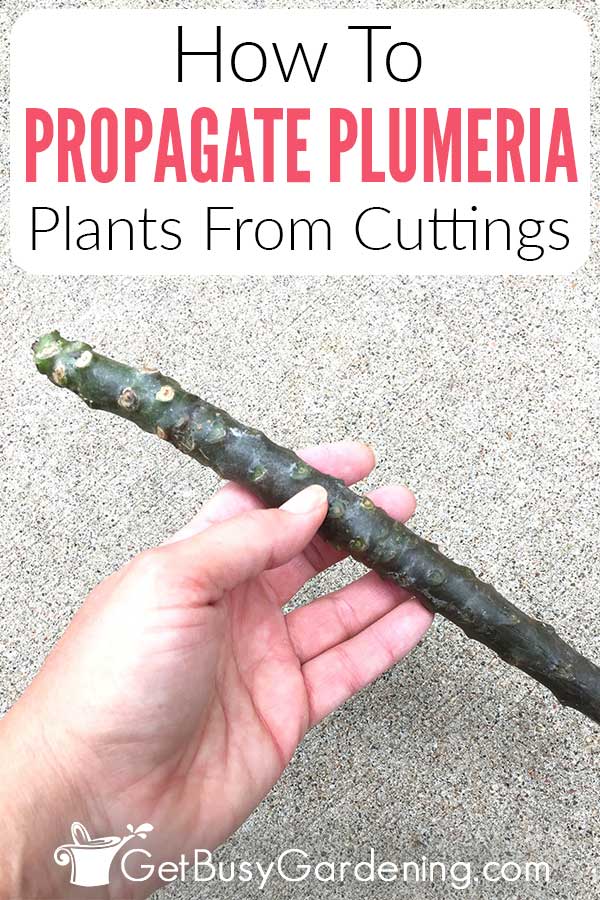

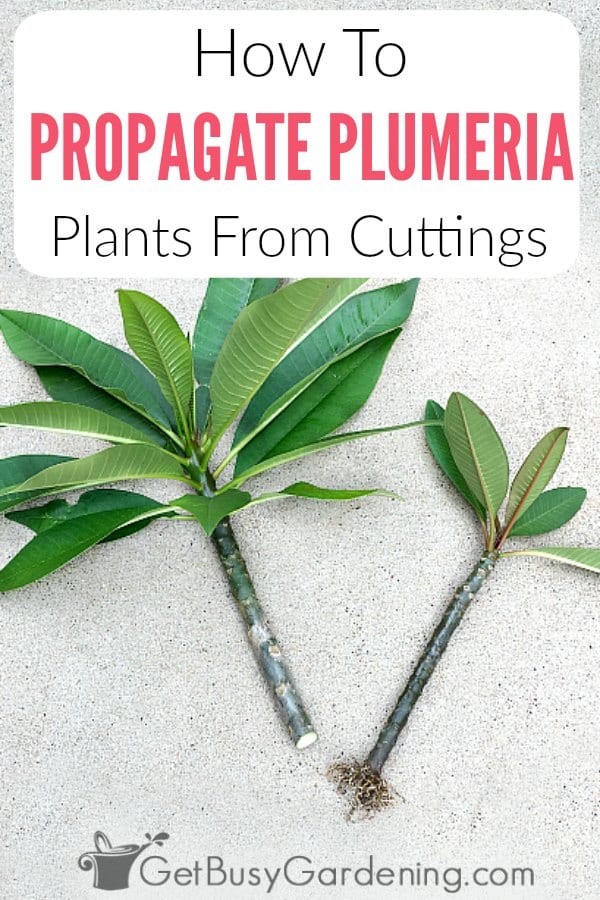

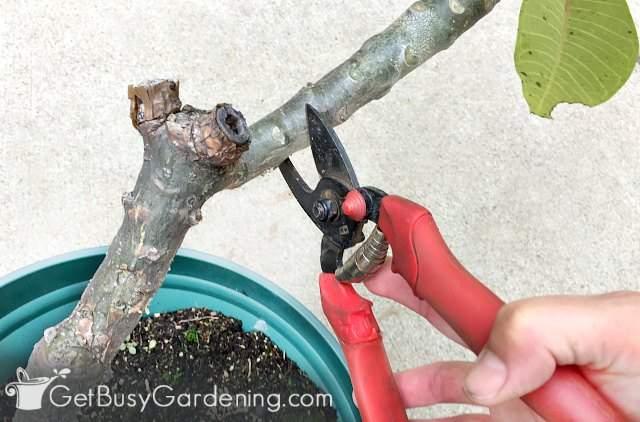
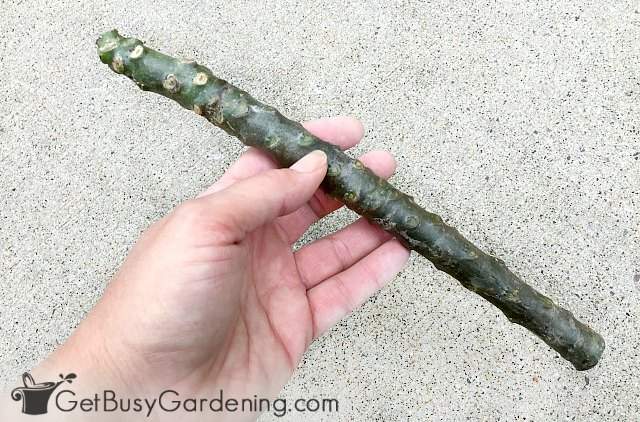


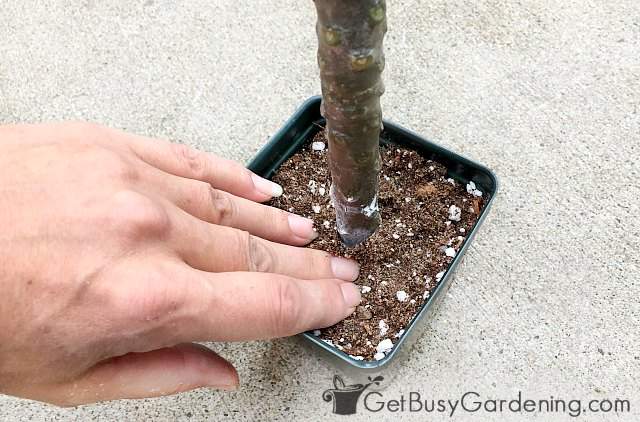

Molly says
Hi! I was given a rooted Plumeria cutting a couple of years ago. It has never bloomed, but it is about 3′ tall. Everything that I have read says that it will only bloom once it has branches, but I don’t know how to get it to branch off! All it ever gives me are leaves! What do you recommend I do to get it to bloom? (I use Dr. Earth Exotic blend fertilizer.)
Amy Andrychowicz says
All you have to do to get your plumeria to branch out is prune off the top. You can root the part that you cut off, and the remaining stem will grow new branches right below the spot where you made the cut.
Amy Andrychowicz says
Oops, hit reply too fast and missed your question about fertilizer, LOL! They are heavy feeders and need regular feedings to bloom. Dr Earth is a great brand, just get the one that is for flowering plants – it will be higher in phosphorus (which is the middle number on the label). A general mix or one higher in nitrogen will encourage more leaves rather than flowers. Here’s my full plumeria care guide that will give you more details. 🥰
chris says
Thank you so much for this article…..
I live in Vietnam and got two cuttings for free from workers pruning plumeria at a highway rest area 3 years ago…… Now the little buggers have grown so much that it’s time to start thinking about cutting them and making more of them; your article HELPED….. 😉
Lana says
Hi Amy. I just found out that my potted plumeria developed black rot near the ground and it is the end of October now. I’m in California. Should I try to root cuttings now or try to overwinter it? The stems of the plant are a bit wrinkled but it looks like its roots are all rotten. Or is there a way to save the whole plant?
Thank you, Lana
Amy Andrychowicz says
Unfortunately once a plumeria starts rotting, the plant can’t be saved. 🙁 I would take as many healthy cuttings as you can ASAP, because the rot usually spreads pretty quickly. Then you can either try rooting them this fall, or try overwintering them until the spring. Good luck!
Deborah Callahan says
I was able to salvage my plumeria tree that seemed to have root rot.
While several of the branches were shriveling and soft, some were still okay. I cut the soft branches off until I got to an area that was not soft. A few days later, I checked again and trimmed a bit more. Then we just crossed our fingers. That was about two years ago when our yard was flooded with salt water from Hurricane Ian and we had also had a wet summer. The tree flowered this year and had flowers as late as two weeks ago (early Dec). I haven’t found any more rotted areas on the tree, so I’m hoping it will survive.
Amy Andrychowicz says
Yay, I’m so happy to hear you were able to save your plumeria!! It sounds like yours had tip-rot, which they are notorious for. You did exactly the right thing by cutting off the rot as it appeared, great job! As you found out, it IS possible to save a plumeria if the branches are rotting from the top dow. But if the whole plant is rotting from the ground up – or it has root rot, then taking cuttings and rooting them is usually the only way to save the plant.
Lauren Puhala says
I live in Ohio and it is September. My daughter just purchased some cuttings in Florida from Just Plumerias. I’m not sure how long I can keep them before trying to root them. When would you suggest I start so that I can have flowers next summer?
Amy Andrychowicz says
I would start your plumeria cuttings now. They may not grow much until spring, so let the soil dry between light waterings throughout the winter.
Mel Bennett says
Hi Amy;
I trade growing what are two Plumaria’s around 20 years ago up here in Anchorage, Alaska, but they didn’t survive because I probably overwater down, but I’ve gotten much better with my house plantings and I am thinking of trying another one or two and I have a nice south facing window. I am currently even drawn a gardenia again, and I seem to have good luck with them, and with a Tabernaemontana plant and a euphorbia (ruby red) and a fairy magnolia, but I am just wondering because I cannot seem to find it on any Plumaria help site about when I can expect a foot barrier that I would buy at a nursery as far as when they will bloom! Is there a general height, if you take care of them well and they like their situation, as to when I can expect the first blooms to show up? I would appreciate any help on this! I’ll be planted them in a fairly large pot and I’ll be planting them in cactus soil just to be on the safe side and I am sure that we will have enough light even here for them to get through the winter on ! After all, my past, and present gardenias have survived!
Amy Andrychowicz says
Plumeria cuttings can bloom their first summer, there’s no minimum size.
Mel Bennett says
Thanks for understanding my post enough so that you could answer it well enough! What about potted Plumarias? When should they bloom if their growing conditions are keeping them happy? Can they also bloom the same year as when I got them, even if I am in a northern climate like Anchorage, Alaska, or will they likely need to wait to bloom until the next spring/summer? And should I cut back on the water and not water them until they start to wilt, during the winter? Since we’re clouded up most of the time during the winter I’m also not sure if I should perhaps pull them back away from the south facing window or not. Should I just leave them there anyway or what would you suggest? I should probably hold off on fertilizing them until spring, right?
Amy Andrychowicz says
You’re welcome! Here are a few articles that will help you and answer all of your questions…
How To Care For Plumeria Plants (Hawaiian Frangipani)
How To Overwinter Plumeria (Frangipani) Plants Indoors
How To Grow Plumeria In A Pot
Ricardo Garza says
Just purchased these plumerias in Hawaii. Live in California Hope I can get is the grow
Amy Andrychowicz says
Oh how fun! Good luck, I hope the plumeria cuttings will take root for you and grow well!